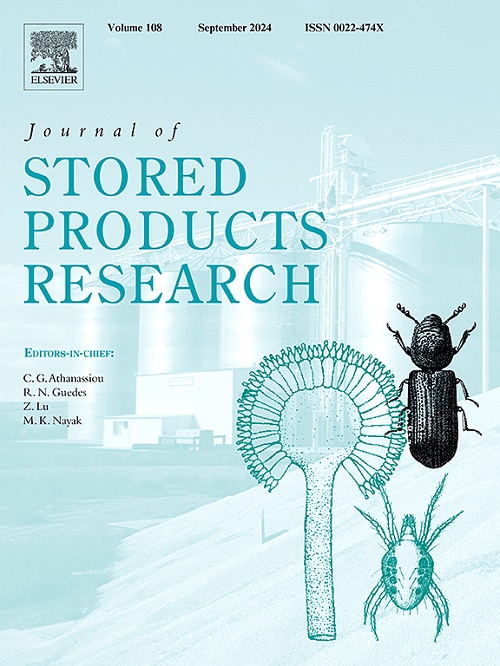新鲜和冷冻干果螨(Carpoglyphus lactis)支持具有特殊生态位需求的捕食性螨(蜱螨螨科)的饲养
IF 2.7
2区 农林科学
Q1 ENTOMOLOGY
引用次数: 0
摘要
植物表面的结构特征对植螨的生存和发育起着至关重要的作用,但其具体要求仍未得到充分研究。我们研究了纤维材料和叶片毛状体对捕食螨 Phytoseius leaki Schicha 的生存和生活史特征的影响。尽管可以获得丰富的食物和水分,但在缺乏纤维材料的人工饲养细胞中,没有个体存活到蜕皮期,这表明结构线索对未成熟发育至关重要。质子若虫在死亡前的摄食量极少,这表明缺乏合适的栖息地可能会诱发应激相关效应。织物基质与毛夜蛾(Solanum mauritianum Scop.)叶片的比较显示,叶片表面的毛夜蛾发育加快,但繁殖力和寿命降低,这可能是由于有毒生化产物造成的。实验室试验表明,活的和冷冻的 Carpoglyphus lactis (L.) 卵都能支持 P. leaki 的发育和繁殖,不过冷冻卵会减少活螨的干扰和废物的积累。这些发现突出了 P. leaki 的结构要求,强调了叶片毛状体在形成其栖息地分布方面的重要性,以及在管理与短柔毛植物相关的害虫方面的潜在作用。本文章由计算机程序翻译,如有差异,请以英文原文为准。

Fresh and frozen dried fruit mites (Carpoglyphus lactis) supported the rearing of a predatory mite Phytoseius leaki (Acari: Phytoseiidae) with specialised niche requirements
The structural features of plant surfaces play a crucial role in the survival and development of phytoseiid mites, yet the specific requirements remain understudied. We investigated the effects of fibrous materials and leaf trichomes on the survival and life history traits of a predatory mite, Phytoseius leaki Schicha. Despite access to abundant food and moisture, no individuals survived to the deutonymph stage in artificial rearing cells lacking fibrous materials, suggesting that structural cues are essential for immature development. Protonymphs exhibited minimal feeding before mortality, indicating that the absence of a suitable niche may have induced stress-related effects. Comparisons between fabric substrates and the leaf discs of woolly nightshade (Solanum mauritianum Scop.) revealed accelerated development on leaf surfaces but reduced fecundity and lifespan, potentially due to toxic biochemical products. Laboratory trials demonstrated that both live and frozen Carpoglyphus lactis (L.) eggs supported the development and reproduction of P. leaki, although frozen eggs reduced interference from live mites and waste accumulation. These findings highlight the structural requirements of P. leaki, emphasising the importance of leaf trichomes in shaping its habitat distribution and potential role in managing pests associated with pubescent plants.
求助全文
通过发布文献求助,成功后即可免费获取论文全文。
去求助
来源期刊
CiteScore
5.70
自引率
18.50%
发文量
112
审稿时长
45 days
期刊介绍:
The Journal of Stored Products Research provides an international medium for the publication of both reviews and original results from laboratory and field studies on the preservation and safety of stored products, notably food stocks, covering storage-related problems from the producer through the supply chain to the consumer. Stored products are characterised by having relatively low moisture content and include raw and semi-processed foods, animal feedstuffs, and a range of other durable items, including materials such as clothing or museum artefacts.

 求助内容:
求助内容: 应助结果提醒方式:
应助结果提醒方式:


